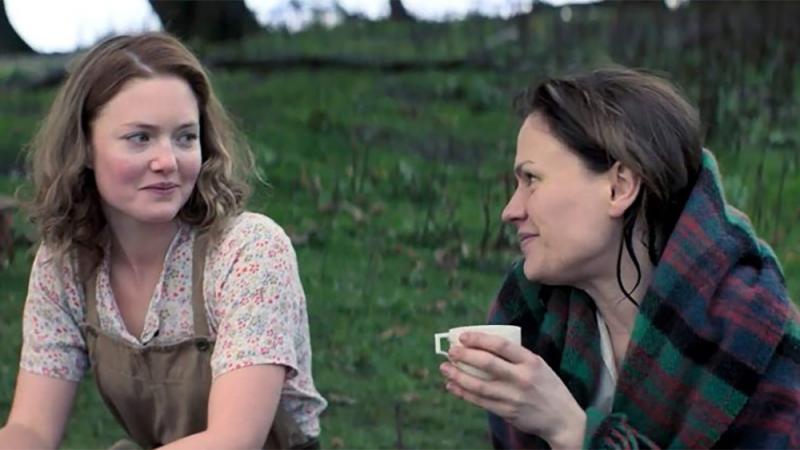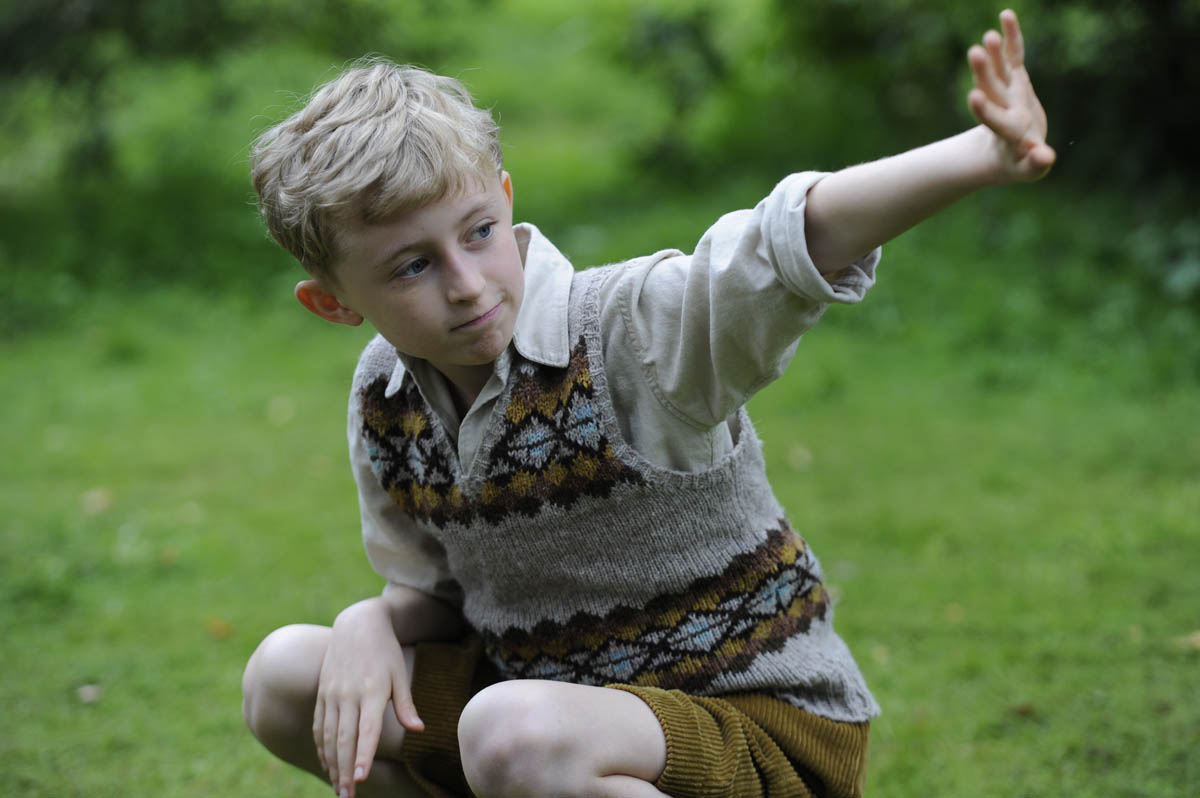Tell It to the Bees review - taboo love in 1950s Scotland | reviews, news & interviews
Tell It to the Bees review - taboo love in 1950s Scotland
Tell It to the Bees review - taboo love in 1950s Scotland
A woman doctor changes the lives of a struggling factory worker and her young son

In Tell It to the Bees, sex is aberrant unless it’s conducted by a straight married couple. Since Annabel Jankel’s low-key drama is set in a grim Scottish mill town in 1952, you can add “white” to that dictum.
Based on the semi-autobiographical third novel by Fiona Shaw, Tell It to the Bees is a solid movie – at least until it mobilises a swarm of the eponymous insects as a deus ex machina. However, the screenplay by Henrietta Ashworth and Jessica Ashworth doesn’t offer a clear enough sense of who the protagonist is. Is it Lydia, whose abandonment by her surly husband Robert (Emun Elliott) has left her weepy and craving intimacy? Or is it her son Charlie (Gregor Selkirk, pictured below), a schoolboy who serves as witness to Lydia’s evolving love life and is affected by her choices? They are both sympathetic characters, but the viewer needed anchoring in one or other of them.
As an observer of “illicit” adult behaviour, Charlie has much in common with the Victorian lad in The Go-Between (filmed twice) and the son of Carey Mulligan’s character in Wildlife. It’s often disturbing for pre-adolescents to discover their parents having sex. Discovering one of them having sex with a person who isn’t the other parent can be devastating. In Dennis Potter’s The Singing Detective, the young Philip Marlow is given a horrendous Oedipal blow by witnessing his mother being done in the Forest of Dean by a more virile man than his father: as an adult entrapped in a psychosomatic disease, Marlow re-enacts the incident in a series of masochistic fantasies. In contrast, Charlie isn’t psychologically damaged, apparently, by seeing Lydia having sex with her lover. He is shocked at the time and flees to live with Robert, who has moved in nearby with Pam and her daughter Annie (Lauren Lyle). Charlie soon wants to return to Lydia. His reaction is muted because he didn’t find her in bed with a rampaging Alpha male but the gentle woman doctor Jean Markham (Anna Paquin in fine form). Once banished from the town by her father for being a lesbian, Jean has returned, following his death, to take up his practice.
In contrast, Charlie isn’t psychologically damaged, apparently, by seeing Lydia having sex with her lover. He is shocked at the time and flees to live with Robert, who has moved in nearby with Pam and her daughter Annie (Lauren Lyle). Charlie soon wants to return to Lydia. His reaction is muted because he didn’t find her in bed with a rampaging Alpha male but the gentle woman doctor Jean Markham (Anna Paquin in fine form). Once banished from the town by her father for being a lesbian, Jean has returned, following his death, to take up his practice.
Jean met Charlie when he came to her as a patient, bonded with him by showing him her beehives, and offered him and Lydia rooms in her spacious house when, unsupported by Robert, they were evicted from their home. Seven years after the war, ex-soldier Robert hasn’t readjusted to civvy street. The film (if not Lydia initially) resists his gruff, overbearing machismo and his threatening moustache. (He’s a milder version of the abusive husband, a Scottish World War I casualty, in Terence Davies’ Sunset Song.)
Charlie’s voiceover narration, which is spoken (by Billy Boyd) at the beginning and end of the film as a man looking back on these events, reflects that Lydia and Jean’s love had, in fact, eased his own journey into adulthood. As much was hinted when he denied Robert’s wish to bring him up in order to make a real man of him because, he says, he can’t be one. The film’s addressing of intolerance extends beyond same-sex romance. Annie is overjoyed when her boyfriend makes her pregnant, but Pam intervenes because he is West Indian. The outcome is bloody.
Skilfully played by Grainger, Lydia is educated (she associates telling secrets to bees to “The Bee-Boy’s Song” from Kipling’s Puck of Pook’s Hill) and intelligent, but also reactive and lacking in self-awareness. When Pam call her “wild", she presumably means “over-sexed". There’s a baffling scene in which Charlie spies on her, the lone woman in a pub, getting drunk and dancing with a predatory man after she’s been fired from her job. She doesn’t notice Jean’s attraction to her when they first take tea. Paquin’s eyes – those of a discreet woman falling in love at first sight – register Jean’s fear and uncertainty, but also the possibility that Lydia may reciprocate her feelings. Jean’s bees eventually bring them together.
Lovingly tended by Charlie (and lovingly photographed in close-up by cinematographer Bartosz Nalazek), the bees have a metaphoric role to play – nature, which has its own logic, is fierce and won’t be trammelled by man-made rules (not in 1952 anyway). Jankel, co-creator of the 1980s AI TV host Max Headroom and director of the 2009 TV movie Skellig: The Owl Man, handles the bees well until they embark on their US Cavalry mission.
The future of Arts Journalism
You can stop theartsdesk.com closing!
We urgently need financing to survive. Our fundraising drive has thus far raised £49,000 but we need to reach £100,000 or we will be forced to close. Please contribute here: https://gofund.me/c3f6033d
And if you can forward this information to anyone who might assist, we’d be grateful.

Subscribe to theartsdesk.com
Thank you for continuing to read our work on theartsdesk.com. For unlimited access to every article in its entirety, including our archive of more than 15,000 pieces, we're asking for £5 per month or £40 per year. We feel it's a very good deal, and hope you do too.
To take a subscription now simply click here.
And if you're looking for that extra gift for a friend or family member, why not treat them to a theartsdesk.com gift subscription?
more Film
 Little Trouble Girls review - masterful debut breathes new life into a girl's sexual awakening
Urska Dukic's study of a confused Catholic teenager is exquisitely realised
Little Trouble Girls review - masterful debut breathes new life into a girl's sexual awakening
Urska Dukic's study of a confused Catholic teenager is exquisitely realised
 Young Mothers review - the Dardennes explore teenage motherhood in compelling drama
Life after birth: five young mothers in Liège struggle to provide for their babies
Young Mothers review - the Dardennes explore teenage motherhood in compelling drama
Life after birth: five young mothers in Liège struggle to provide for their babies
 Blu-ray: Finis Terrae
Bleak but compelling semi-documentary, filmed on location in Brittany
Blu-ray: Finis Terrae
Bleak but compelling semi-documentary, filmed on location in Brittany
 Oslo Stories Trilogy: Sex review - sexual identity slips, hurts and heals
A quietly visionary series concludes with two chimney sweeps' awkward sexual liberation
Oslo Stories Trilogy: Sex review - sexual identity slips, hurts and heals
A quietly visionary series concludes with two chimney sweeps' awkward sexual liberation
 Sorry, Baby review - the healing power of friendship in the aftermath of sexual assault
Eva Victor writes, directs and stars in their endearing debut feature
Sorry, Baby review - the healing power of friendship in the aftermath of sexual assault
Eva Victor writes, directs and stars in their endearing debut feature
 Blu-ray: Who Wants to Kill Jessie?
Fast-paced and visually inventive Czech comedy
Blu-ray: Who Wants to Kill Jessie?
Fast-paced and visually inventive Czech comedy
 Oslo Stories Trilogy: Love review - freed love
Gay cruising offers straight female lessons in a heady ode to urban connection
Oslo Stories Trilogy: Love review - freed love
Gay cruising offers straight female lessons in a heady ode to urban connection
 Beating Hearts review - kiss kiss, slam slam
Romance and clobberings in a so-so French melodrama
Beating Hearts review - kiss kiss, slam slam
Romance and clobberings in a so-so French melodrama
 Materialists review - a misfiring romcom or an undercooked satire?
Writer-director Celine Song's latest can't decide what kind of film it is
Materialists review - a misfiring romcom or an undercooked satire?
Writer-director Celine Song's latest can't decide what kind of film it is
 theartsdesk Q&A: actor Leonie Benesch on playing an overburdened nurse in the Swiss drama 'Late Shift'
The Guildhall-trained German star talks about the enormous pressures placed on nurses and her admiration for British films and TV
theartsdesk Q&A: actor Leonie Benesch on playing an overburdened nurse in the Swiss drama 'Late Shift'
The Guildhall-trained German star talks about the enormous pressures placed on nurses and her admiration for British films and TV
 Freakier Friday review - body-swapping gone ballistic
Lindsay Lohan and Jamie Lee Curtis's comedy sequel jumbles up more than their daughter-mother duo
Freakier Friday review - body-swapping gone ballistic
Lindsay Lohan and Jamie Lee Curtis's comedy sequel jumbles up more than their daughter-mother duo

Add comment